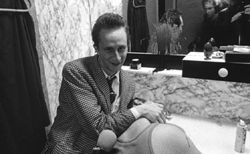The Eternal Frame - Ant Farm & T.R. Uthco - 1976
At first I didn’t really understand why I was
viewing this. I chose to watch this last. Not for any particular reason. It became
apparent to me that this had something in common with the other films. I didn’t
realize it until they started doing the reenactments of JFK’s assassinations.
One by one more people would show up to watch. One lady even claimed that she
wish she had he camera with her. There were camera’s recording everything, in
turn, there was also a camera recording the people recording everything. I find
this most similar the “White Bear” were all of the people have their cell
phones out recording.
Man Bites Dog, Black
Mirror
This film was pretty morbid. It was
documentary style and seemed extremely real. I kept telling myself that there
was no way that they could legally film this if it were real. You could tell
that the crew was freaked out by the main character’s actions in the beginning.
They seemed to be careful around him during the whole film, worried that he
could flip out at any time. When the crew was hesitant to get shellfish with
him I was a little worried for them. Just because this man was so
unpredictable. He didn’t hesitate to kill anyone. He seemed to enjoy being
filmed. After awhile, the crew seemed to start taking part in what he was
doing. They accepted his cash, they helped toss and hide bodies, they all raped
a woman, and most of all, and they continued to let everything happen. They didn’t
try to stop the man once. They were just so wrapped up in getting everything on
film.
Season 2 Ep. 2, "White Bear"
So, this woman wakes up every single day
without any clue as to what is going on. She has no idea who she is or where
she is. The camera follows her almost in a handheld manner, but not as shaky.
Anyway, she wakes up and goes outside—all we see are people on their mobile
phones recording her. I just wanted to scream at everyone and tell them to wake
up. She pleads for help but everyone is absorbed by his or her phones. Which is
kind of how it is today, in the “real world.” So many people are quick to film
something, while very few are there to jump in and help.
Later we find out that
this woman is being punished for filming the murder of a little girl. The
people want her to suffer over and over again. They have an elaborate park and
set up to make this happen. Her memory is erased every night until she wakes up
and goes through everything again. She is also not supposed to look at any phones
while she is going through this because they seem to trigger memories. I wasn’t
expecting everyone to be watching when it was first revealed. I found myself
feeling sympathetic for this woman even though I knew what she did was
horrible. We live in a weird world where people will go and watch
assassinations on YouTube and whatnot. I’ve just never really had any interest
in that.



















